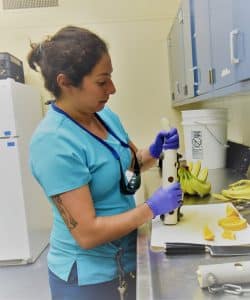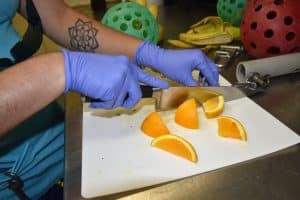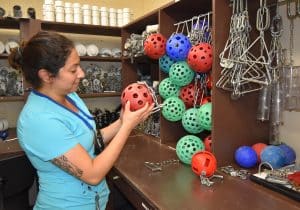Podcast: Play in new window | Download (Duration: 8:37 — 12.2MB)
Subscribe: Apple Podcasts | TuneIn | RSS | More

The animal enrichment programs at the Southwest National Primate Research Center aim to stimulate species-typical behaviors and promote psychological well-being using social, physical, occupational, feeding and sensory enrichment opportunities, many of which mimic natural behaviors seen in the wild, which we aim to encourage. We also want to prevent or limit the occurrence of abnormal behaviors, which may result from the stress or boredom that sometimes occurs in a captive environment. We use enrichment devices to invite and encourage a wide range of species-typical behaviors that primates living in the wild express. Foraging, locomotion and socializing are all examples of species-typical behaviors.
We have developed an Environmental Enhancement Plan that codifies these principles. Also, a list and description of devices can be found in our Enrichment Device Manual, and recipes for treats are found in our new Enrichment Cookbook.
Almost all of the primates at SNPRC are housed in groups. They spend much of their time interacting socially, including grooming each other. This rich social environment is important for the well-being of all primates, and is particularly critical for developing infants.
For primates that are housed indoors for research, we pair as many individuals as possible. The primates can also see, hear and sometimes touch other primates with which they are not directly housed.
All cages are equipped with some form of structural enrichment, such as climbing structures, perches or swings. Baboons, chimpanzees and other monkeys are very agile. They can jump great distances and walk along a rope or chain with ease. They also like to rest in areas above the ground, where they can get away from others in their group if they wish, or just get a better view of the surroundings.

We provide many additional types of structural enrichment, including hanging 55-gallon drums, perches made from PVC or metal pipes, rope and chain swings and tire swings.
The baboon corrals have large culverts and climbing structures that also provide shade. The roofs of most chimpanzee housing areas are made of pipes so that the chimpanzees can brachiate from one area to another.
We provide a stable, nutritionally complete diet and additional fruits, grains and vegetables to all primates. Our feeding enrichment program also includes foods that are not available very often, such as seasonal fruits, pumpkins at Halloween, yogurt or frozen juice treats.
Occupational enrichment includes devices to stimulate problem-solving behavior, motor skills and coordination. Some foods are placed in special devices so that the animal has to spend some time extracting it. For example, balls filled with grain and peanuts must be moved around or shaken so that the food pieces fall out of small holes drilled in the side. Working to acquire food in this manner is similar to foraging for food in the wild.
Feeding devices for chimpanzees include those that require the use of a tool. Our simulated termite mounds are filled with applesauce, oatmeal, spaghetti sauce or other thick liquids. The chimpanzees use straws or sticks to poke down into the pipe and pull out a small amount of food at a time. This is a similar process that wild chimpanzees use to get termites or ants from their nests using twigs.
Many of our enrichment items increase sensory stimuli; the favorite taste of peanut butter, the new smell of a toy or the feel of a kiwi fruit. Some items are given specifically to elicit particular sensations. For example, mirrors can be attached to the wall so the animals can view their neighbors, radios are placed in indoor areas for extra auditory stimuli and televisions are located in many indoor areas for chimpanzees and monkeys to view television shows and children’s and nature videos.

All primates are very good at manipulating their environments. They have opposable thumbs and are very strong and persistent. We provide a wide variety of toys and other objects for our primates to manipulate. Most primates like hard plastic balls. They hold them, sit on them, carry them around and of course, chew on them.
Other durable toys include hollow rubber toys, nylon dog bones and metal rattles attached to the cage. We provide new toys regularly to keep interest high. Sometimes, items that can be destroyed are even more popular. For example, the chimpanzees like to shred and make nests out of paper.